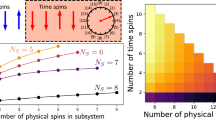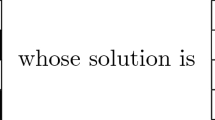Abstract
This work considers an open two-level quantum system evolving under coherent and incoherent piecewise constant controls constrained in their magnitude and variations. The control goal is to steer an initial pure density matrix into a given target density matrix in a minimal time. A machine learning algorithm was developed, which combines the approach of \(k\) nearest neighbors and training a multi-layer perceptron neural network, to predict suboptimal final times and controls. For 18 sets of initial pure states with different size (between 10 and 200) training datasets were constructed. The numerical results are described, including the analysis of the dependence of the quality of the machine learning algorithm on the size of the training set.






Similar content being viewed by others
REFERENCES
S. J. Glaser, U. Boscain, T. Calarco, C. P. Koch, W. Köckenberger, R. Kosloff, I. Kuprov, B. Luy, S. Schirmer, T. Schulte-Herbrüggen, D. Sugny, and F. K. Wilhelm, ‘‘Training Schrödinger’s cat: Quantum optimal control. Strategic report on current status, visions and goals for research in Europe,’’ Eur. Phys. J. D 69, 279 (2015). https://doi.org/10.1140/epjd/e2015-60464-1
A. G. Butkovskiy and Y. I. Samoilenko, Control of Quantum-Mechanical Processes and Systems (Nauka, Moscow, 1984; Kluwer Acad. Publ., Dordrecht, 1990).
M. Shapiro and P. Brumer, Principles of the Quantum Control of Molecular Processes (Wiley, Hoboken, 2003).
D. J. Tannor, Introduction to Quantum Mechanics: A Time Dependent Perspective (Univ. Science Books, Sausilito, CA, 2007). https://www.uscibooks.com/tannor.htm.
D. D’Alessandro, Introduction to Quantum Control and Dynamics (CRC Press, Boca Raton, 2007).
V. Letokhov, Laser Control of Atoms and Molecules (Oxford Univ. Press, New York, 2007).
A. L. Fradkov, Cybernetical Physics. From Control of Chaos to Quantum Control (Springer, New York, 2007).
C. Brif, R. Chakrabarti, and H. Rabitz, ‘‘Control of quantum phenomena: Past, present and future,’’ New J. Phys. 12, 075008 (2010). https://doi.org/10.1088/1367-2630/12/7/075008
H. M. Wiseman and G. J. Milburn, Quantum Measurement and Control (Cambridge Univ. Press, Cambridge, 2010).
D. Dong and I. R. Petersen, ‘‘Quantum control theory and applications: A survey,’’ IET Control Theory Appl. 4, 2651–2671 (2010). http://dx.doi.org/10.1049/iet-cta.2009.0508
K. W. Moore, A. Pechen, X.-J. Feng, J. Dominy, V. J. Beltrani, and H. Rabitz, ‘‘Why is chemical synthesis and property optimization easier than expected?,’’ Phy. Chem. Chem. Phys. 13, 10048–10070 (2011). https://doi.org/10.1039/C1CP20353C
A. M. Zagoskin, Quantum Engineering. Theory and Design of Quantum Coherent Structures (Cambridge Univ. Press, Cambridge, 2011).
C. P. Koch, ‘‘Controlling open quantum systems: Tools, achievements, and limitations,’’ J. Phys.: Condens. Matter 28, 213001 (2016). https://doi.org/10.1088/0953-8984/28/21/213001
O. V. Morzhin and A. N. Pechen, ‘‘Krotov method for optimal control of closed quantum systems,’’ Russ. Math. Surv. 74, 851–908 (2019). https://doi.org/10.1070/RM9835
A. Pechen and H. Rabitz, ‘‘Teaching the environment to control quantum systems,’’ Phys. Rev. A 73, 062102 (2006). https://doi.org/10.1103/PhysRevA.73.062102
A. Pechen, N. Il’in, F. Shuang, and H. Rabitz, ‘‘Quantum control by von Neumann measurements,’’ Phys. Rev. A 74, 052102 (2006). https://doi.org/10.1103/PhysRevA.74.052102
A. Pechen, ‘‘Engineering arbitrary pure and mixed quantum states,’’ Phys. Rev. A 84, 042106 (2011). https://doi.org/10.1103/PhysRevA.84.042106
A. N. Pechen and A. S. Trushechkin, ‘‘Measurement-assisted Landau-Zener transitions,’’ Phys. Rev. A 91, 052316 (2015). https://doi.org/10.1103/PhysRevA.91.052316
D.-Y. Dong, C.-L. Chen, T.-J. Tarn, A. Pechen, and H. Rabitz, ‘‘Incoherent control of quantum systems with wavefunction controllable subspaces via quantum reinforcement learning,’’ IEEE Trans. Syst., Man Cybern., Part B 38, 957–962 (2008). https://doi.org/10.1109/TSMCB.2008.926603
M. Y. Niu, S. Boixo, V. N. Smelyanskiy, and H. Neven, ‘‘Universal quantum control through deep reinforcement learning’’ npj Quantum Inform. 5, 33 (2019). https://doi.org/10.1038/s41534-019-0141-3
J. P. P. Zauleck and R. de Vivie-Riedle, ‘‘Constructing grids for molecular quantum dynamics using an autoencoder,’’ J. Chem. Theory Comput. 14, 55–62 (2018). https://doi.org/10.1021/acs.jctc.7b01045
S. C. Hou and X. X. Yi, ‘‘Quantum Lyapunov control with machine learning,’’ Quantum Inf. Process. 19 (1), 8 (2020). https://doi.org/10.1007/s11128-019-2470-8
P. Palittapongarnpim and B. C. Sanders, ‘‘Enter the machine,’’ Nat. Phys. 14, 432–433 (2018). https://doi.org/10.1038/s41567-018-0061-8
G. Torlai, G. Mazzola, J. Carrasquilla, M. Troyer, R. Melko, and G. Carleo, ‘‘Neural-network quantum state tomography,’’ Nat. Phys. 14, 447–450 (2018). https://doi.org/10.1038/s41567-018-0048-5
J. Gao, L.-F. Qiao, Z.-Q. Jiao, Y.-C. Ma, C.-Q. Hu, R.-J. Ren, A.-L. Yang, H. Tang, M.-H. Yung, and X.-M. Jin, ‘‘Experimental machine learning of quantum states,’’ Phys. Rev. Lett. 120, 240501 (2018). https://doi.org/10.1103/PhysRevLett.120.240501
I. A. Luchnikov, S. V. Vintskevich, D. A. Grigoriev, and S. N. Filippov, ‘‘Machine learning non-Markovian quantum dynamics,’’ Phys. Rev. Lett. 24, 140502 (2020). https://doi.org/10.1103/PhysRevLett.124.140502
O. V. Morzhin and A. N. Pechen, ‘‘Minimal time generation of density matrices for a two-level quantum system driven by coherent and incoherent controls,’’ Int. J. Theor. Phys. (2019). https://10.1007/s10773-019-04149-w.
O. V. Morzhin and A. N. Pechen, ‘‘Maximization of the overlap between density matrices for a two-level open quantum system driven by coherent and incoherent controls,’’ Lobachevskii J. Math. 40 (10), 1532–1548 (2019). https://doi.org/10.1134/S1995080219100202
O. V. Morzhin and A. N. Pechen, ‘‘Maximization of the Uhlmann–Jozsa fidelity for an open two-level quantum system with coherent and incoherent controls,’’ Phys. Part. Nucl. 51 (4), 464–469 (2020). https://doi.org/10.1134/S1063779620040516
A. C. Müller and S. Guido, Introduction to Machine Learning with Python: A Guide for Data Scientists (O’Reilly Media, Sebastopol, CA, 2016).
I. Goodfellow, Y. Bengio, and A. Courville, Deep Learning (The MIT Press, Cambridge, MA, 2017).
A. Géron, Hands-On Machine Learning with Scikit-Learn, Keras, and TensorFlow: Concepts, Tools, and Techniques to Build Intelligent Systems, 2nd ed. (O’Reilly Media, Sebastopol, CA, 2019).
A. J. Meade and A. A. Fernandez, ‘‘The numerical solution of linear ordinary differential equations by feedforward neural networks,’’ Math. Comput. Model. 19 (12), 1–25 (1994). https://doi.org/10.1016/0895-7177(94)90095-7
R. Storn and K. Price, ‘‘Differential evolution—A simple and efficient heuristic for global optimization over continuous spaces,’’ J. Global Optimiz. 11, 341–359 (1997). https://doi.org/10.1023/A:1008202821328
Dual Annealing Optimization in SciPy. https://docs.scipy.org/doc/scipy/reference/generated/scipy.optimize.dual_annealing.html.
C. Tsallis and D. A. Stariolo, ‘‘Generalized simulated annealing,’’ Phys. A (Amsterdam, Neth.) 233, 395–406 (1996). https://doi.org/10.1016/S0378-4371(96)00271-3
Y. Xiang and X. G. Gong, ‘‘Efficiency of generalized simulated annealing,’’ Phys. Rev. E 62, 4473–4476 (2000). https://doi.org/10.1103/PhysRevE.62.4473
Differential Evolution Optimization in SciPy. https://docs.scipy.org/doc/scipy/reference/generated/scipy.optimize.differential_evolution.html.
L. Accardi, Y. G. Lu, and I. V. Volovich, Quantum Theory and Its Stochastic Limit (Springer, Berlin Heidelberg, 2002).
H.-P. Breuer and F. Petruccione, Quantum Systems, Channels, Information (Oxford Univ. Press, New York, 2007).
E. A. Rakhmanov, E. B. Saff, and Y. M. Zhou, ‘‘Minimal discrete energy on the sphere,’’ Math. Res. Lett. 1, 647–662 (1994). https://doi.org/10.4310/MRL.1994.v1.n6.a3
E. B. Saff and A. B. J. Kuijlaars, ‘‘Distributing many points on a sphere,’’ Math. Intell. 19, 5–11 (1997). https://doi.org/10.1007/BF03024331
Matplotlib, Plotting Library. https://matplotlib.org/.
Solving Ordinary Differential Equations with scipy.integrate.odeint. https://docs.scipy.org/doc/scipy/reference/generated/scipy.integrate.odeint.html.
\(R^{2}\) Score, the Coefficient of Determination. https://scikit-learn.org/stable/modules/model_evaluation.html #r2-score.
Multi-Layer Perceptron Regressor in Scikit-Learn. https://scikit-learn.org/stable/modules/generated/sklearn.neural_network.MLPRegressor.html.
Neural Network Models Supervised in Scikit-Learn. https://scikit-learn.org/stable/modules/neural_networks_supervised.html.
D. P. Kingma and J. Ba, ‘‘Adam: A method for stochastic optimization,’’ arXiv:1412.6980 [cs.LG] (2014). https://arxiv.org/abs/1412.6980.
sqlite3 Module. https://docs.python.org/3/library/sqlite3.html.
pickle Module. https://docs.python.org/3/library/pickle.html.
Least Squares Polynomial Fit with numpy.polyfit. https://docs.scipy.org/doc/numpy/reference/generated/numpy.polyfit.html.
Funding
Derivation of the dynamical equations given in Section 2.2 was performed in [27] within the project no. 1.669.2016/1.4 of the Ministry of Science and Higher Education of the Russian Federation. Other results were obtained within the project of the Russian Science Foundation no. 17-11-01388 in Steklov Mathematical Institute of Russian Academy of Sciences.
Author information
Authors and Affiliations
Corresponding authors
Additional information
(Submitted by S. A. Grigoryan)
Rights and permissions
About this article
Cite this article
Morzhin, O.V., Pechen, A.N. Machine Learning for Finding Suboptimal Final Times and Coherent and Incoherent Controls for an Open Two-Level Quantum System. Lobachevskii J Math 41, 2353–2368 (2020). https://doi.org/10.1134/S199508022012029X
Received:
Revised:
Accepted:
Published:
Issue Date:
DOI: https://doi.org/10.1134/S199508022012029X




